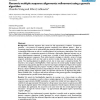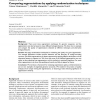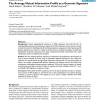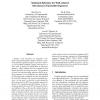BMCBI
2011
13 years 4 months ago
2011
Background: The substitution rates within different nucleotide contexts are subject to varying levels of bias. The most well known example of such bias is the excess of C to T (C ...
ISAMI
2010
13 years 11 months ago
2010
Probabilistic models of languages are fundamental to understand and learn the profile of the subjacent code in order to estimate its entropy, enabling the verification and predicti...
BMCBI
2005
14 years 26 days ago
2005
Background: Genomic sequence data cannot be fully appreciated in isolation. Comparative genomics
BMCBI
2008
14 years 1 months ago
2008
Background: Metagenomics is an approach to the characterization of microbial genomes via the direct isolation of genomic sequences from the environment without prior cultivation. ...
BMCBI
2007
14 years 1 months ago
2007
Background: There exist many segmentation techniques for genomic sequences, and the segmentations can also be based on many different biological features. We show how to evaluate ...
BMCBI
2008
14 years 1 months ago
2008
Background: Occult organizational structures in DNA sequences may hold the key to understanding functional and evolutionary aspects of the DNA molecule. Such structures can also p...
ISMB
1997
1997
Inferring Gene Structures in Genomic Sequences Using Pattern Recognition and Expressed Sequence Tags
14 years 2 months ago
Abstract.) Ying Xu, Richard J. MuraF, and Edward C. Uberbacher Computer Science and Mathematics Division and tLife Sciences Division Computational methods for gene identification ...
CSB
2003
IEEE
14 years 6 months ago
2003
IEEE
Distinct, local structures are frequently correlated with functional RNA elements involved in posttranscriptional regulation of gene expression. Discovery of microRNAs (miRNAs) su...
RECOMB
2010
Springer
14 years 7 months ago
2010
Springer
Background: The empirical frequencies of DNA k-mers in whole genome sequences provide an interesting perspective on genomic complexity, and the availability of large segments of g...




